Richard Hallman on the other side of the lens, on Mount Hood. Photo by Asit Rathod
By Ben Jacklet
News Update (February 2025): Action photographer extraordinaire Richard Hallman is recovering in Legacy Emanuel Hospital from a serious accident at Mt. Hood Meadows sustained while photographing skiers and snowboarders dropping off a cornice. Hallman sustained multiple broken ribs after a collision with one of the riders he was photographing, and had to be life-flighted off the mountain. Fortunately his lungs were not damaged from the impact and the broken ribs. He is in pain but recovering.
The first time I observed Richard Hallman working on Mount Hood, I was completely intimidated.
It was the spring of 2013, and I was up shooting mountain photos for a website I was thinking of calling Shred Hood. And yeah: The skiers and snowboarders out on the slopes that day were most definitely Shredding Hood. The jumps were huge, the features terrifying, and I was intensely aware of how much the sport has evolved since I was a five-year-old rocking safety-strap bindings and a puffy down parka in icy New Hampshire, circa 1971.
I had a camera with a long lens, but I didn’t really know what I was doing. That realization became abundantly clear as I took note of the photographer at the center who did know what he was doing. It was Richard Hallman, and he was in his element, squinting into the light, studying the angles, directing daredevils like a slope-side choreographer.
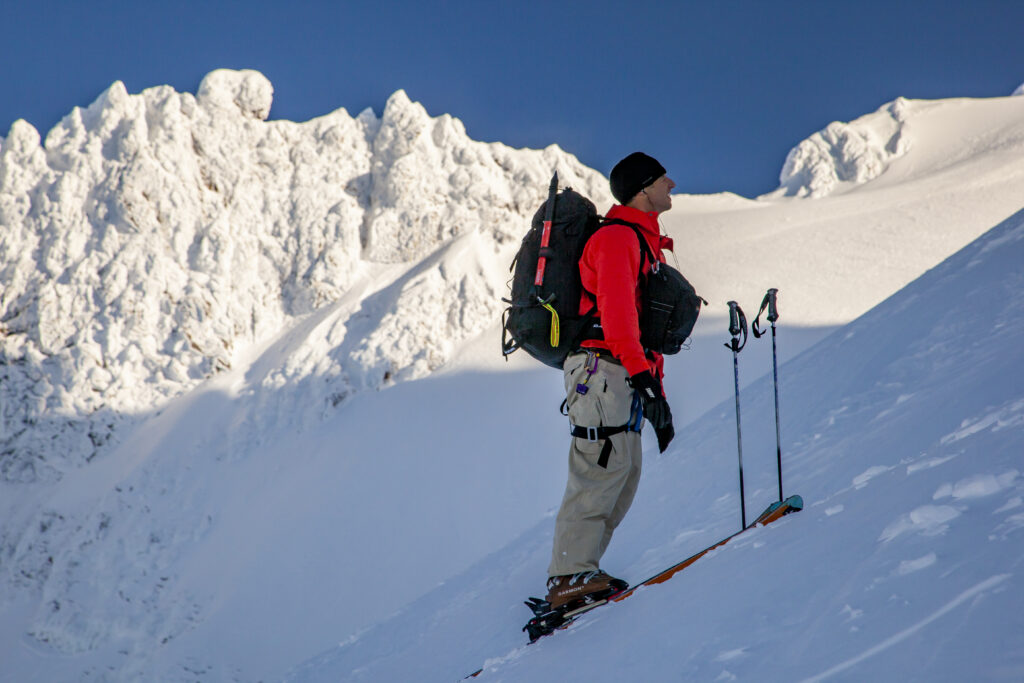
Richard Hallman is a top-tier action sports photographer based in Hood River. His photographs of big-wave surfers, climbers, skiers, snowboarders, windsurfers, mountain bikers and kiteboarders capture the stark beauty of nature at its most extreme, and the people who are drawn to those extremes. He has traveled to some of the most beautiful places on the planet, from New Zealand to Nepal to Maui to Illumination Saddle. His photographs of Mount Hood number in the thousands, dating back to the days of film and slides, and continuing into the future with a long-term book project about the mountain and its revelers.
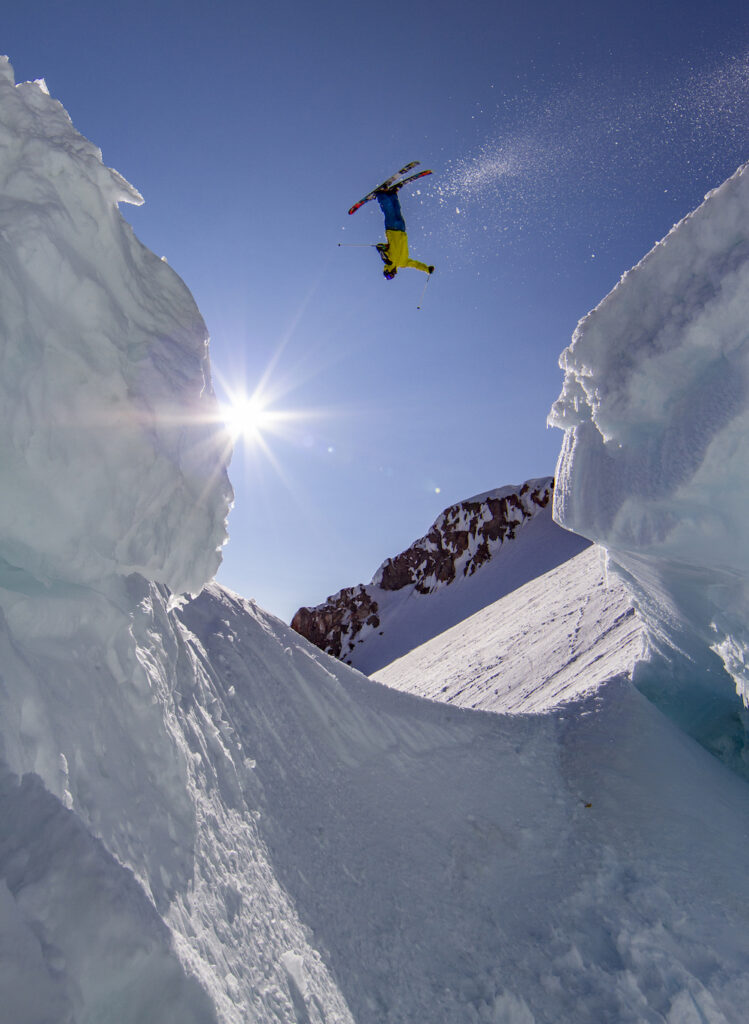
Photo by Richard Hallman: Tommy Ellingson on Mount Hood
In many ways, Hallman has been living the dream. But the extreme moments he documents also come with serious risk. Some of his closest friends have died young while pursuing adventures in far-flung locations, most recently the pro skier and heli guide Greg Harms, who died in a helicopter crash in Alaska on March 27th.
Over the years, as I have gotten to know Hallman better, my intimidation level has gradually subsided. I now recognize Richard as a nuanced human being who happens to have an exceptional gift for photography, which has enabled him to lead an exceedingly adventurous life. Asit Rathod, who has climbed and skied Mount Hood with Hallman many times, says, “Richard Hallman is one of my best friends. We’ve traveled the world skiing, climbing, laughing, crying, while living a charmed life. Love you Brother.”
So how exactly did this happen? How does a kid from the south shore of Lake Michigan grow up to travel the world shooting action photos in their most extreme?
A dark room, a hand-me-down windsurfer, and some brutal lake waves
Hallman, who turns 56 years old this year, grew up in Ogden Dunes, a small beach community on the southern tip of Lake Michigan, near Gary, Indiana.
He loved photography from childhood. His family had a dark room in the house, and his dad, who worked in sales for the freight rail company GATX, was a talented amateur photographer. “I had some friends in high school who were really artistic, and we spent a lot of time going out and wasting film and then coming back to the dark room and wasting paper,” he remembers. “I didn’t realize how expensive all that stuff was until I got to college and I rented dark room time. I’ll never forget calling my father and saying ‘Dad! Why didn’t you tell me how expensive this was?’ He told me, ‘Well, I didn’t want to thwart your inspiration.’ I thought that was brilliant. But still, you could have told me!”
Hallman took one semester of photography in high school. Other than that, he was completely self-taught. From the beginning, he was drawn to the world of action sports. He grew up riding Hobie-Cats, windsurfing, and even surfing (yes, surfing) on Lake Michigan.
“Lake Michigan is 370 miles long, 900 feet deep, and 170 feet wide,” he explains. “You get a long fetch there, and in late summer early fall these storm systems with a consistent north wind. You can get 10, 12-foot waves. It’s not the best surfing because the period is really short, like 12 feet, six seconds, so, it’s really difficult to catch a wave. But it is definitely fun.”
He started skiing at age five and took frequent formative trips to Colorado with his family, to explore the Rockies. His brother got a windsurfer for a graduation present and left it at home for the taking when he took off to college.
After a short stint in college and a brutal job tearing apart 20 miles of railroad, Hallman decided to head out West. He found a job at Breckenridge in Colorado and stayed there for five years, working ski patrol all winter and climbing 14,000-foot peaks all summer. He was doing a lot of photography and improving his skills as he traveled and climbed and skied, but he didn’t have a professional mindset yet. That would come later.
As a lifelong windsurfer, Hallman had been hearing about Hood River since he was a kid. He traveled to Oregon to check it out for the first time in the summer of 1993, and he never left.
‘I could get used to this’
Hood River was where he started getting serious about photography. “I would be out there windsurfing and there would be someone jumping like 30 feet over my head, and I was thinking it would be so cool to be in the water and get this angle, to capture what these guys are doing. Because it’s just insane.”
To support himself, he went back to school and earned his nursing degree, and served as an emergency room nurse in Hood River for 8 years. He spent his spare time out on the river and up on the mountain, shooting photos, getting to know the athletes who are drawn to Hood River and Mount Hood. People were starting to notice the quality of his work. That’s when he started to get invited on trips.
Hallman got his first big break in 2004, when a photographer got injured and a spot opened up to shoot a 10-day snow-kiting trip to the South Island of New Zealand for Kiteboarding Magazine. “We heli-ed up to the top of the Fox Glacier and we were staying at this cool backcountry hut, shooting snow-kiting on the glacier,” Hallman recalls. “And I was thinking, ‘Hmm, I could get used to this.’”
Not long after the New Zealand trip, Hallman gave his boss notice that he planned to become a professional action sports photographer. He also started doing family shoots and wedding photos, filling a new niche for digital-savvy event photographers. The commercial gigs financed his foray into action sports.
In 2005 he got lucky again. His friend Lance Koudele told him about a new big-wave surf contest on the Oregon Coast and suggested he go shoot it. So Hallman headed out to investigate the event now known as the Nelscott Reef Big Wave Classic. It was a beautiful day and the waves were excellent. But the action was too far offshore to capture the images he wanted. Frustrated at missing out, Hallman noticed that the tour organizer, Adam Wagner, was carrying around a 600-mm lens attached to a subpar camera that he wasn’t using, because he was too busy running the event to take photos.
“I finally went up to Adam and just asked him bluntly: ‘Hey, do you mind if I put your lens on my camera to get a few photos?’ It was like a record scratching. He looked at me like, ‘Who the hell are you?’ I said I’m here to help you out. I see that you’re busy. In the end he did let me use his lens, and we hit it off. I ended up being his photographer for 10 years.”
‘Everything is focused on what’s right in front of you. And that’s when you’re most alive.’
Hallman’s work on the Big Wave Tour introduced him to some of the greatest surfers on the planet, like Greg Long, Peter Mel and Kai Lenny. He served as the main water photographer for the first year four years of the legendary Jaws competition at Peahi on Maui.
“If you had told me when I was growing up on Lake Michigan reading Surfing Magazine that I would be the main photographer at the Peahi contest, I never would have believed it,” he says. “I had to pinch myself. How does a white boy from outside of Chicago end up in the middle of one of the greatest big-wave surf spots in the world?”
Shooting those huge waves was a rush. One day on the Oregon Coast, November 2, 2010, Hallman found himself crashing out through monstrous waves on a jet-ski in conditions that were downright terrifying. “It was the scariest ocean I’ve ever been in in my life,” he remembers. “The current was incredibly strong. Luckily nobody died and nobody got hurt, but we did have six skis sink that day. We had waves breaking out there that had to be 70 feet tall…
“I definitely get scared at times like that. But that’s why you’re drawn to those situations. You’re not thinking about the future. You’re not thinking about the past. Everything is focused on what’s right in front of you. And that’s when you’re most alive.”
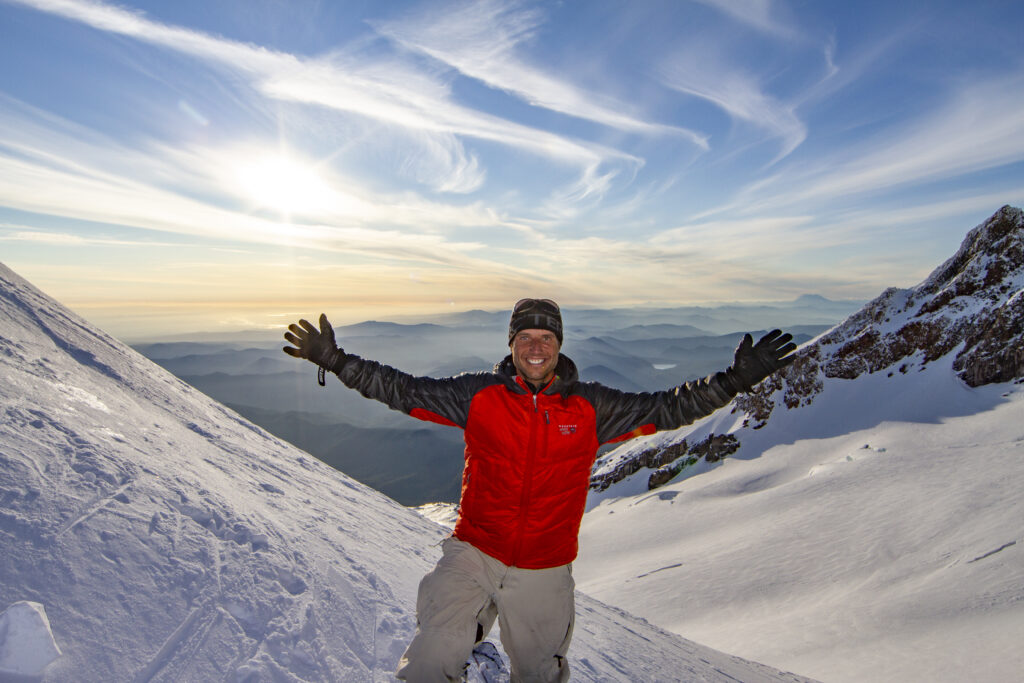
61 Hood Summits, and Counting
Between his work for the Big Wave surf tour and Kiteboarding Magazine, Hallman was spending a lot of quality time on all forms of water. At the same time, he was also expanding the reach of his high-altitude adventures. He summited major peaks such as Aconcagua in Argentina (22,841′), Kilimanjaro in Tanzania (19,341′), and Mount Elbrus in Russia (18,510′). He climbed over 20,000 feet in the Himalayas, high enough to enjoy a 300-degree view that made it look like he was on top of the world – until he turned around to see the peak towering up another 9,000 feet behind him.
The bulk of his high-elevation work has been at his home mountain, Mount Hood (11,239′). Hallman made his first summit up Hood in 1998, and he’s up to 61 summits as of this writing. Between his many climbs and his steady work at Mt. Hood Meadows, he has thousands of stellar photos that he is attempting to archive and edit down to size, with a plan to one day release a major hardcover book capturing Mount Hood in all of its glory. A few examples:
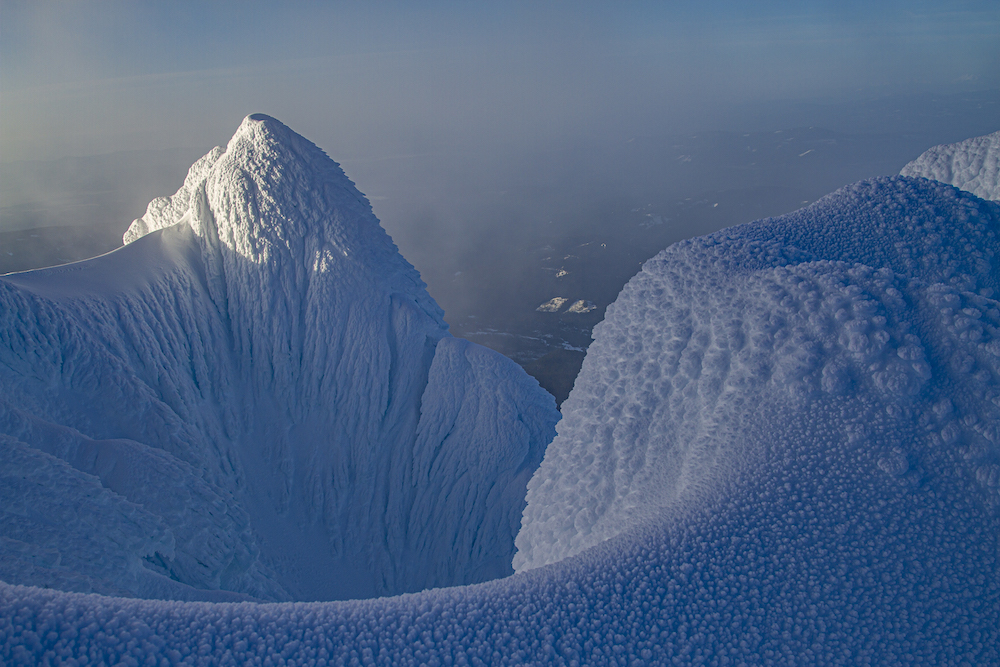
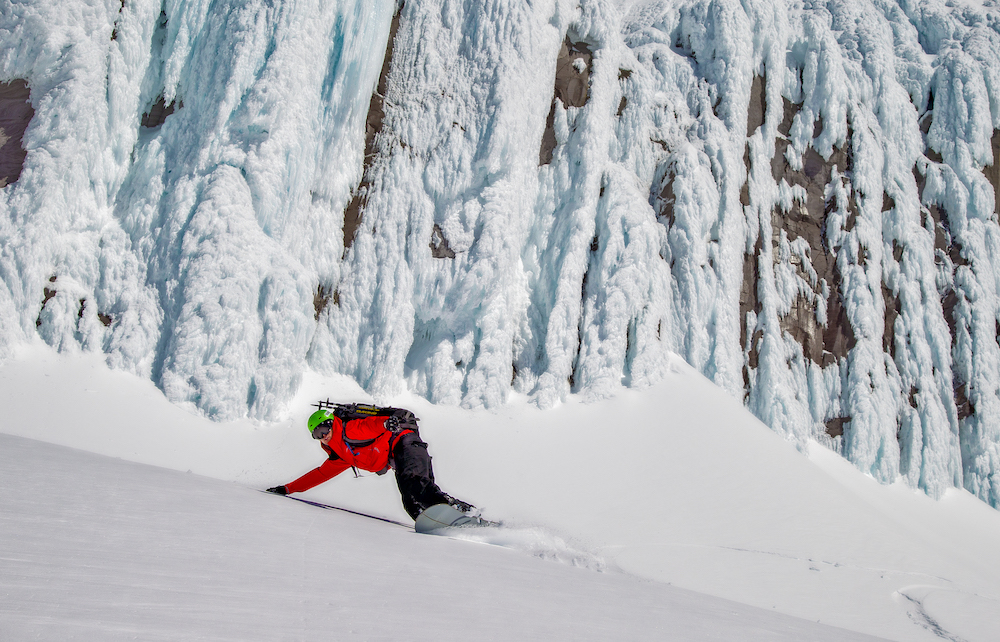
Rider: Aaron Sales – Photo by Richard Hallman
What follows is a sample of a few of Richard Hallman’s Mount Hood photos, with Richard telling the story behind the photos, in his own words:
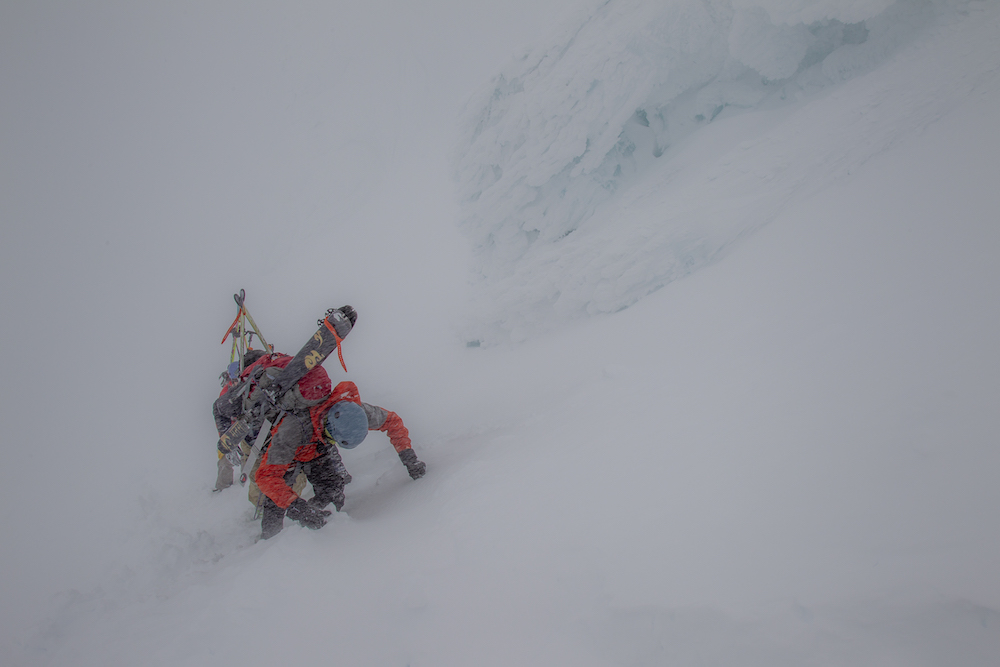
“I was climbing with Mendy Macabee, a doctor in Hood River, and her husband David. We had just summited and it was beautiful blue sky, and then some weather moved in and left us in a whiteout that made it very difficult to get down. It was just us on the summit, and we were about to head down except we really had no idea of where we were going, because we couldn’t see anything. That’s when I saw these guys were coming up. I just loved their determination, to keep going in spite of the conditions, and you can see it in the shot. When we started going down we were struggling to get our bearings because everything is off angle on Hood. You have to go against your instincts and go way left, away from the fall line, or else you are going to end up in Zig Zag Canyon. But if you go too far left you are going to end up in White River Canyon. And if you go too little you are going to end up in the Bergschrund… We were finally able to find our way to the White River Headwall and work our way down from there, but it was definitely an interesting day.”
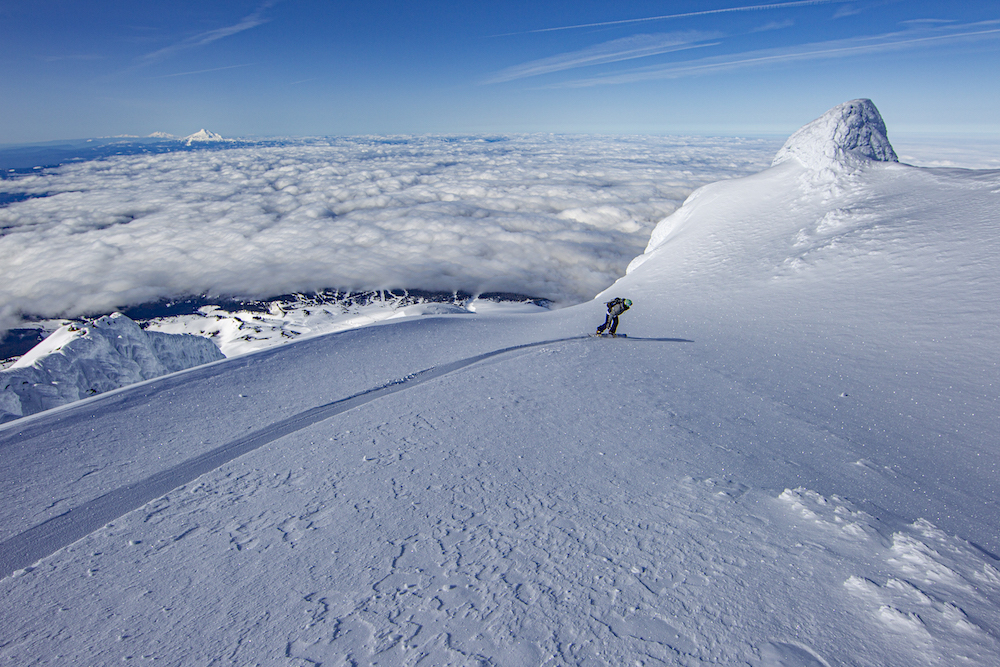
“That’s my friend Rachelle McEwen. She’s an awesome all-around athlete, and she’s also a traveling nurse. I’m really proud of her. She’s been tackling Covid straight-on. She’s up in Bellingham right now on another three-month contract, battling Covid. In this shot we’re up on the summit of Hood. I asked her to draw a line into the distance, and I love the line she drew.”
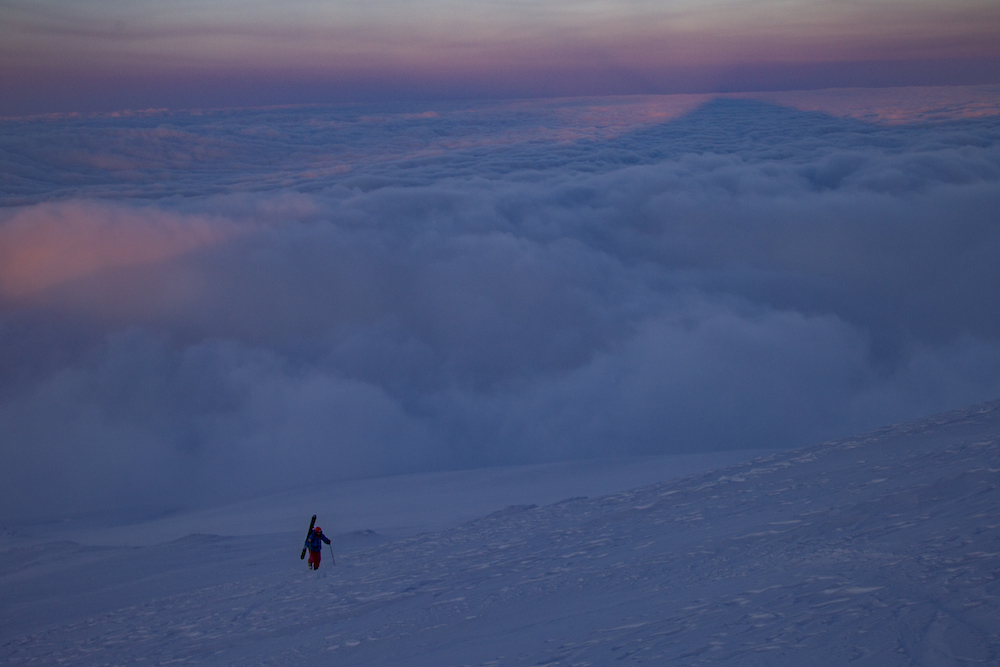
“This is the beginning of the climb. I like spreading out from people to get fresh perspectives. Sometimes I’ll say go ahead, and I’ll hang back. Other times I’ll push myself and work ahead, so I can shoot back. I think that’s Tommy Ellingson. The sunrises on Hood are insane.”
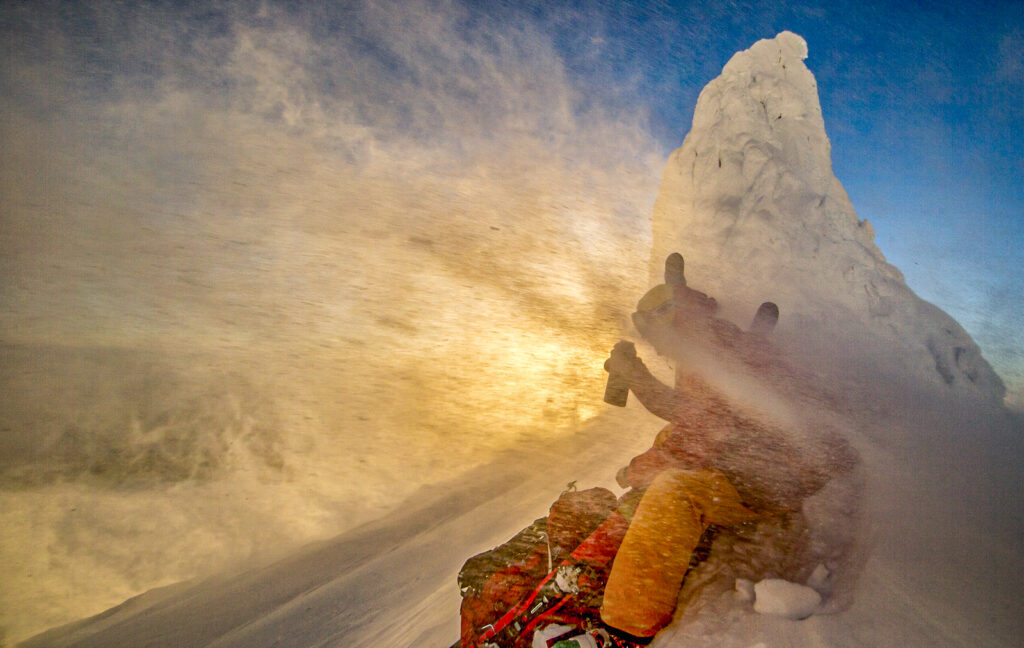
“This was a crazy day. I was up on Hood with Matthias Giraud, Super Frenchie. He’s a big ski-base jumper and an amazing athlete. It was gnarly up there. I’ve climbed all over the world, but this day up on Hood was crazy. It was gusting up to 70 miles an hour and snow was blowing everywhere. It was also close to the shortest day of the year, so the sun was hanging low in the sky. i love the shots we got that day.”
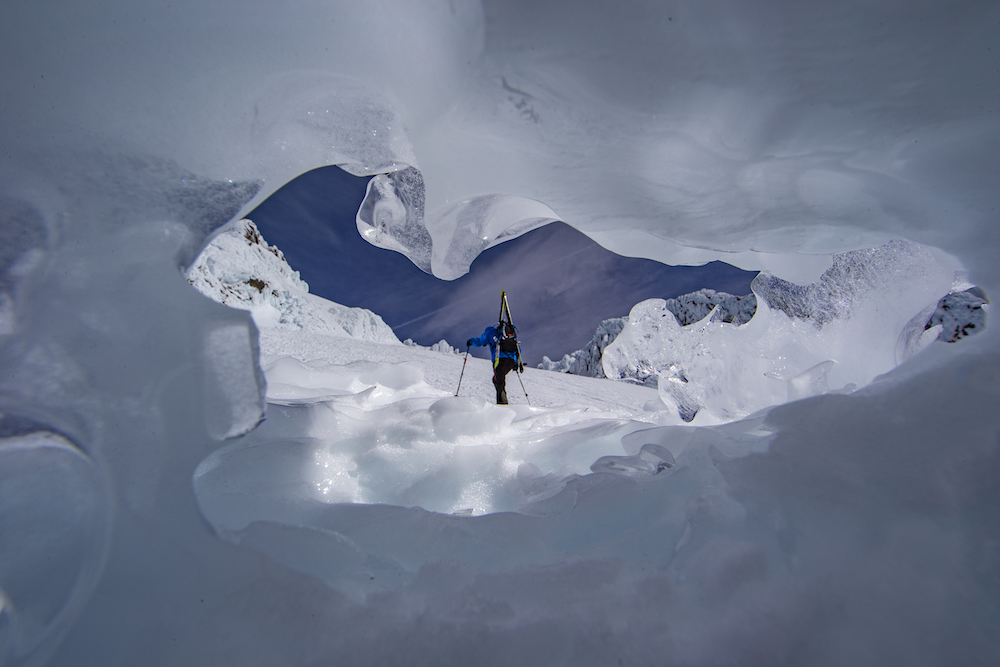
“This is my buddy Dave Watson, an accomplished Himalayan climber who lives in White Salmon. That little cave is literally two feet tall. I could barely get my head in the backside of it to take a picture out of it. We were laughing at how it looks like it’s this big cave in the photo, but it’s really just this tiny thing.”
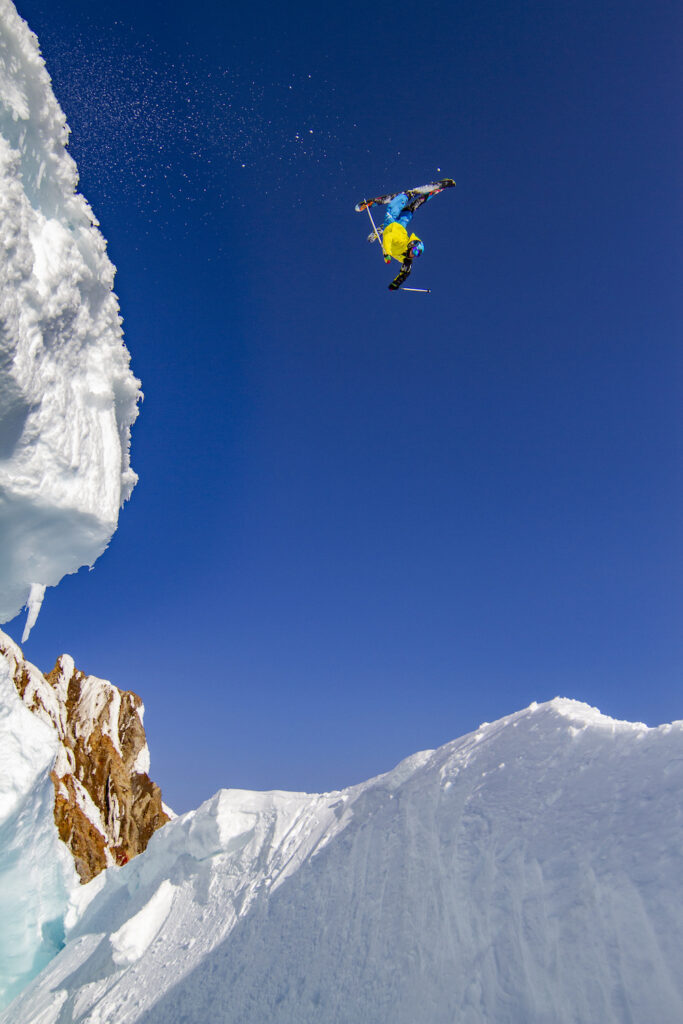
“That’s Tommy Ellingson doing a full backflip over the Bergschrund. The Bergschrund is the first big separation that opens up on the south side of Hood on the climber’s route. Early season, you can just climb right over it, but here that thing is wide open. Tommy and Josh Larkin built a big kicker up there so they could launch over it, and they were going huge. What they were going for was pretty outstanding.”
Hallman has thousands more where these images came from. His effort to cull down his material into just one book is complicated by the fact that he is continually snagging more and more top-shelf material, exploring Mount Hood with outstanding local athletes such as Josh Larkin, Randa Shahin, Erika Vikander, and Asit Rathod.
The hard part will be deciding which images to leave out.
All the photos in this article are protected by copyright, ©RichardHallman
If you are interested in learning more about Richard Hallman and his work or getting in touch with him, you can check his website at richardhallman.com. He is available for all varieties of photo shoots, the more extreme the better.
Shred Hood Editor Ben Jacklet is a writer, editor, and solar energy consultant. He has served as editor and publisher since launching Shred Hood in 2013 and is currently collaborating with Asit Rathod and Richard Hallman on the forthcoming guide book 11,239: A Skiing and Snowboarding Guide from the Summit of Mount Hood, by Asit Rathod, with images by Richard Hallman.
Last modified: February 28, 2025

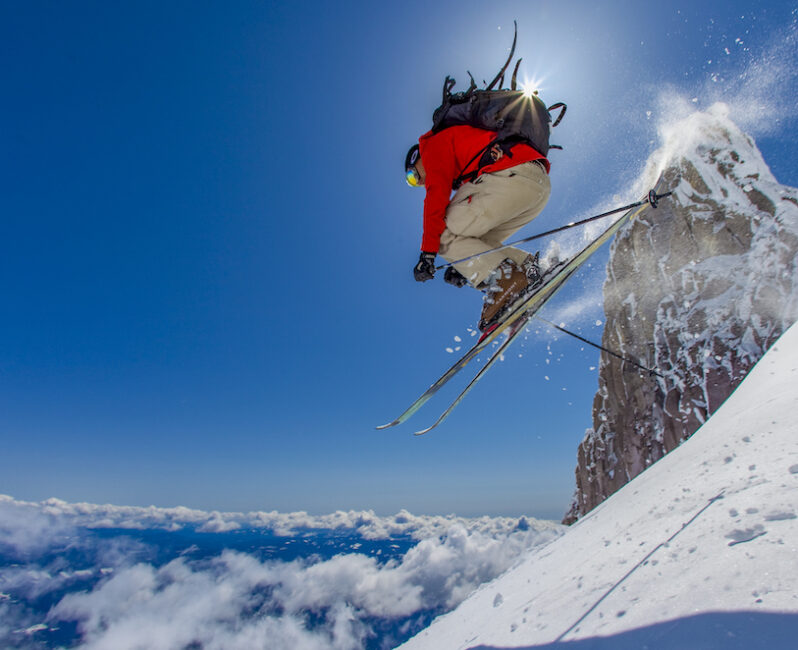
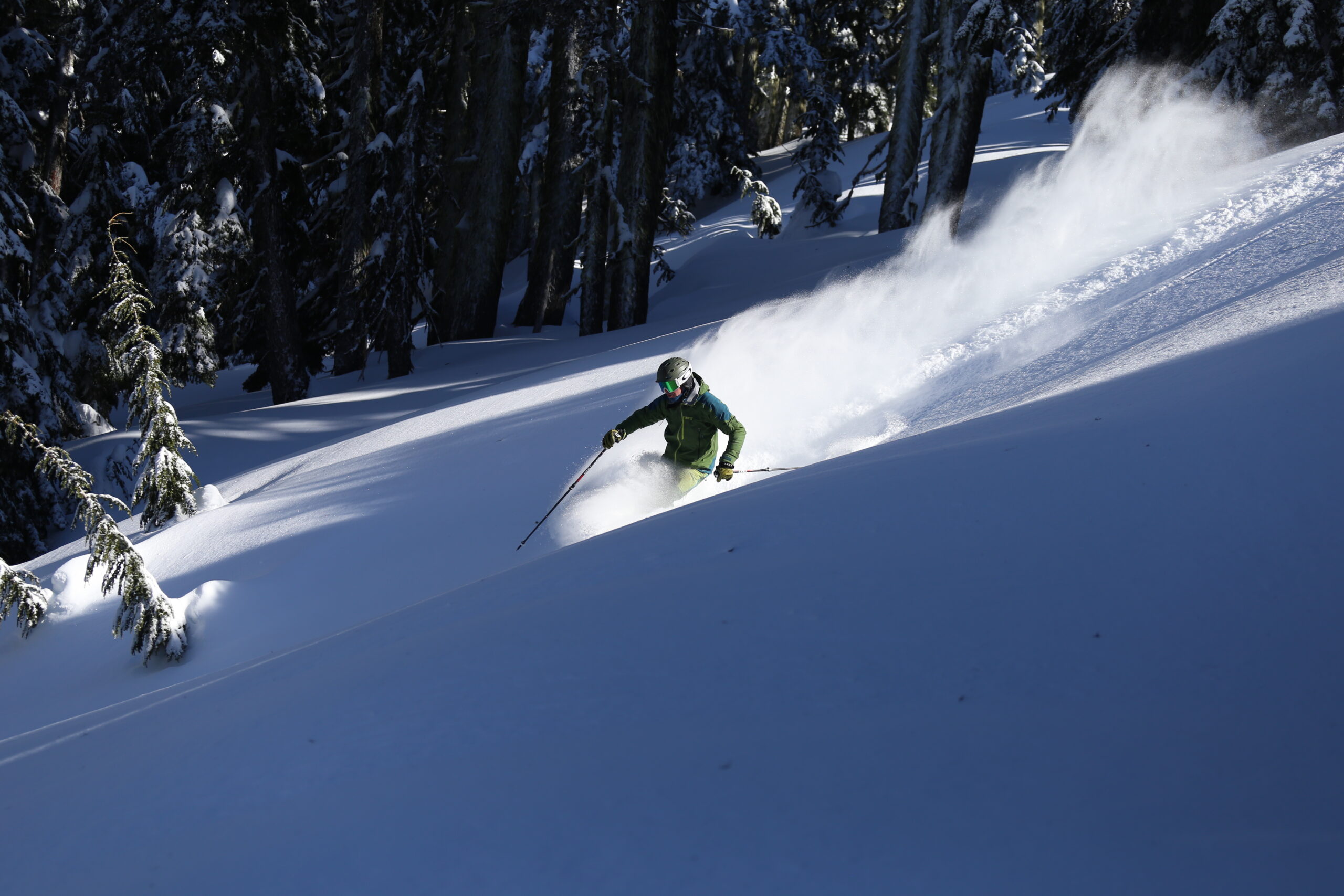
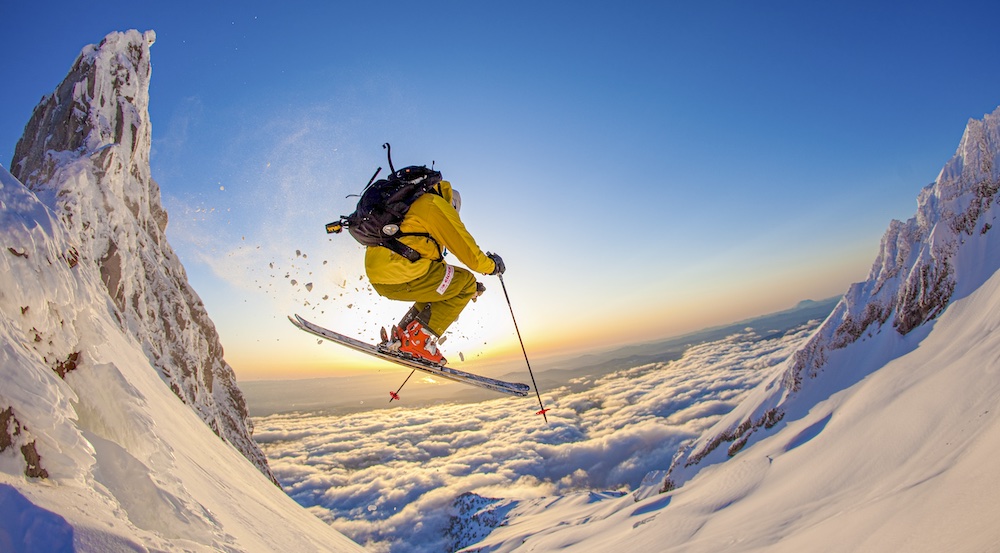

Trix – официальный сайт – сервис мгновенных игр
instagram takipçi satın aldım süper
Turkcell, müşterilerine pek çok farklı hizmet sunuyor ve bunlardan biri de mobil ödeme. Mobil ödemeyi kullanarak fatura ödemesi yapabilir, internet paketi satın alabilir veya diğer pek çok işlemi gerçekleştirebilirsiniz. Ayrıca Turkcell’in “Turkcell Cüzdan” adlı uygulaması sayesinde, cüzdanınızda bulunan parayı da yönetebilirsiniz.
ucuz takipçi satın al